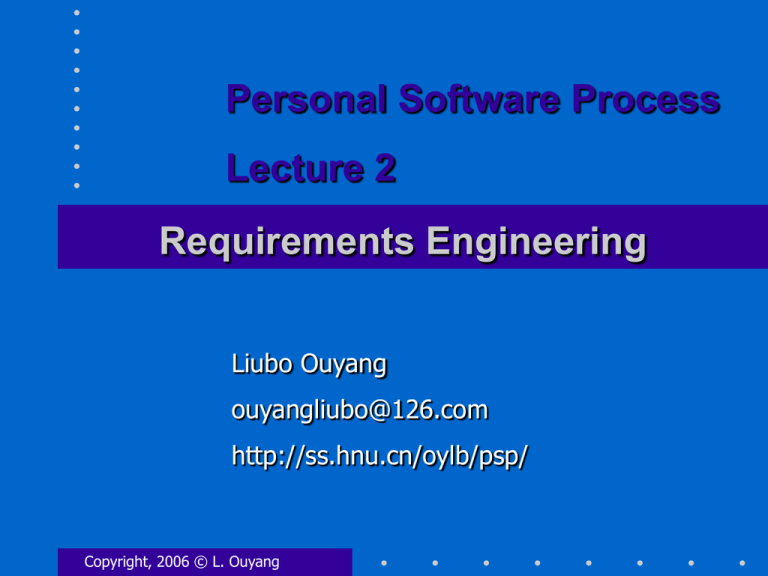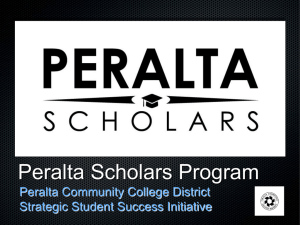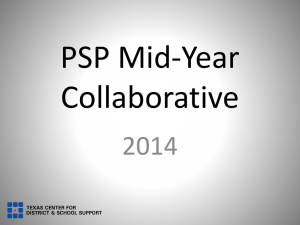Requirements document (2)
advertisement

Personal Software Process Lecture 2 Requirements Engineering Liubo Ouyang ouyangliubo@126.com http://ss.hnu.cn/oylb/psp/ Copyright, 2006 © L. Ouyang Introduction Software engineering vs. system engineering System engineering: • information engineering (a business enterprise) • product engineering (a production process) L.Ouyang, PSP, Lecture 2 Computer-based systems • • • • • • L.Ouyang, PSP, Lecture 2 Software Hardware People Database Documentation Procedures Restraining factors • • • • • L.Ouyang, PSP, Lecture 2 Assumptions Simplifications Limitations Constraints Preferences A good SRS • • • • • • • Unambiguous (one interpretation) Verifiable (one can check that req. are met) Complete (responses to invalid input) Consistent (no conflicts between req.) Modifiable (changes are not a big problem) Traceable (origin of each req. is clear) Usable during the Operation and Maintenance Phase L.Ouyang, PSP, Lecture 2 Source Documents for Requirements .doc Manual SRS Ver. n L.Ouyang, PSP, Lecture 2 SRS Ver. n+1 Source Documents for Requirements List of SD4Rs # Type Title From Since Place Comments 1 Email SRS Nowak 9.11.99 SDS/ 2 SD4R: Source document for requirements Types of SD4R: Email Video File Audio Hard(copy) ... L.Ouyang, PSP, Lecture 2 Ambiguous Advice: Try to keep all the SD4Rs as text files Requirements document (1) 1. Introduction 1.1 Purpose of the document 1.2 Scope of the product 1.3 Definitions, acronyms and abbreviations 1.4 References 1.5 Overview of the document L.Ouyang, PSP, Lecture 2 Requirements document (2) 2. General description 2.1 Product perspective 2.2 Viewpoints 2.2.1 Stakeholders 2.2.2 Users 2.2.3 Domain 2.2.4 Components 2.3 System architecture and use cases in UML 2.4 General constraints 2.5 Assumptions and dependencies L.Ouyang, PSP, Lecture 2 Requirements document (3) 3. Technical requirements 3.1 Functional requirements 3.1.1 Requirement 1 3.1.1.1 Introduction Viewpoint and source(s) Firmness and importance Verifiability and clarity 3.1.1.2 Inputs 3.1.1.3 Processing 3.1.1.4 Outputs L.Ouyang, PSP, Lecture 2 Requirements document (4) 3.1.2 Requirement 2 .. 3.2 External interface requirements 3.2.1 User interfaces 3.2.2 Hardware interfaces 3.2.3 Software interfaces 3.2.4 Communication interfaces 3.3 Performance requirements L.Ouyang, PSP, Lecture 2 Requirements document (5) 3.4 Design constraints 3.4.1 Standards compliance 3.4.2 Hardware limitations ... 3.5 Attributes 3.5.1 Security 3.5.2 Maintainability ... L.Ouyang, PSP, Lecture 2 Requirements document (6) 3.6 Other requirements 3.6.1 Database 3.6.2 Operations 3.6.3 Site adaptation 3.6.4 Training ... 3.7 Non-technical requirements Appendixes Index L.Ouyang, PSP, Lecture 2 FAST FAST = Facilitated Application Specification Technique JAD (Joint Application Development) is another approach to FAST L.Ouyang, PSP, Lecture 2 FAST for SDS Persons involved Facilitator (student of class1) - runs the meeting(s) Recorder (student of class2) - takes notes, serves tape recorder or video recorder Developers (student of class3) and customer representatives (1 for each view) - work on requirements Supervisor - know about the meeting date & time L.Ouyang, PSP, Lecture 2 FAST for SDS Input documents (1) Product request ( Project Proposal, in the customer’s language, HTML 3.0) Information about FAST place (Laboratory Centre?, 9:00 - 15:00) and time (2 - 4 hours by 20.3.2007) should be agreed by 15.3.007 (customer, student of class1, and the Laboratory centre director) L.Ouyang, PSP, Lecture 2 FAST for SDS The list of stakeholders and views should be ready before the project leaders start to organise the FAST meeting. Get from the customer the initial list of requirements sources (manuals, organisation charts, technical data, ..) and read it before the FAST meeting. If not feasible, the meeting can be conducted via phone or e-mail. L.Ouyang, PSP, Lecture 2 FAST for SDS Input documents (2) Worksheet to fill in: Missing stakeholders Missing requirements sources Objects (devices, documents, etc.): • external to the system • produced by the system • internal - used by the system Services that manipulate the objects Constraints (cost, size, time, accuracy, ..) L.Ouyang, PSP, Lecture 2 FAST for SDS A FAST meeting Product justification (every one should agree) ~ n x 1’ Presentation of the worksheets (one by one, no critique) ~ n x 15’ Deciding (discussion) about: • Stakeholders ~ n x 1’ • System architecture (objects) ~ n x 5’ • Services ~ n x 10’ • Constraints ~ n x 5’ • Lecture 2 Validation criteria ~ n x 5’ L.Ouyang, PSP, FAST for SDS Meeting outcomes Direct: • Meeting minutes Indirect: • Software Requirements Specification (validation criteria!) L.Ouyang, PSP, Lecture 2 Davis’ Principles for RE • Understand the problem before you begin to create the analysis model • Develop prototypes showing how the humanmachine interaction will occur • Record the origin of and the reason for every requirement • Use multiple views of requirements (data, functional, and behavioural) • Prioritise requirements • Work to eliminate ambiguity L.Ouyang, PSP, Lecture 2 Viewpoints negotiation A viewpoint represents partial information L.Ouyang, PSP, Lecture 2 An example of viewpoints Viewpoint = perspective on a system An example: traffic lights Prospective stakeholders (viewpoints): • drivers • cyclists • pedestrians • emergency services • the highway authority L.Ouyang, PSP, Lecture 2 Viewpoints in RE Viewpoints: early stages of requirements elicitation Viewpoint-oriented methods: • CORE (G. Mullery, 1979) • SADT • PREview (I. Sommerville, P. Sawyer, 1997) L.Ouyang, PSP, Lecture 2 Typical viewpoints The system’s stakeholders (a human, role, or organisation) The system’s operating environment (other system/component) The system’s domain (phenomena inherent in the application domain; constraints on the system) L.Ouyang, PSP, Lecture 2 Basic RE activities <= 50 zł Requirements elicitation L.Ouyang, PSP, Lecture 2 Basic RE activities for 50 zł ? Requirements analysis L.Ouyang, PSP, Lecture 2 Basic RE activities There is a conflict between your requirements .. Requirements negotiation L.Ouyang, PSP, Lecture 2 The PREview process Requirements elicitation Requirements analysis Requirements negotiation Requirements definition L.Ouyang, PSP, Lecture 2 Local vs. global requirements Types of requirements Local requirements Global requirements (specific to a particular (likely to be most viewpoint) expensive to change) Global requirements = external requirements L.Ouyang, PSP, Lecture 2 Concerns A concern = a top-level, overriding goal Concerns: • crucial to the success • non-negotiable • vaguely defined • concepts rather than concrete properties • serve as constraints • converted into external requirements L.Ouyang, PSP, Lecture 2 TCS: Train Control System A human driver Aim: to monitor & to intervene when safety is in danger If a train goes too fast or crosses a stopping point, TCS will apply the emergency breaks Hardware System Interface (HSI) L.Ouyang, PSP, Lecture 2 TCS: Train Control System TCS’ concerns: • Safety (contribution to train safety) • Compatibility with the HSI interface Concern question for compatibility: Is the requirement consistent with the interface provided by the HSI module ? L.Ouyang, PSP, Lecture 2 TCS: Train Control System A request: calculate a minimum breaking distance Required parameters: • speed, • mass, • line gradient, • track surface conditions Question: are those values available through the HSI interface ? L.Ouyang, PSP, Lecture 2 Compatibility requirements External requirements for the ‘compatibility’ concern: ER4: The TCS software shall be executed in the Ada environment ER5: The TCS software shall execute within the application cycle of the existing on-board software ER6: The TCS software shall react to the change of state within 280 ms ER7: The real-time performance of the existing on-board software shall be maintained L.Ouyang, PSP, Lecture 2 The safety concern Hazards identification: hazard analysis techniques (fault-tree analysis, causeconsequence analysis, ..) TCS’ hazards: • excess speed, • overshooting a stopping point L.Ouyang, PSP, Lecture 2 Safety requirements ER1: The system shall detect the occurrence of excess speed ER2: The system shall detect the occurrence of overshoot ER3: The system shall apply emergency breaking when either excess speed or overshoot are detected L.Ouyang, PSP, Lecture 2 Viewpoint identification Model of organisational Model of operational environment environment Domain expertise Stakeholder Component User Domain viewpoints viewpoints viewpoints viewpoints L.Ouyang, PSP, Lecture 2 TCS viewpoints Stakeholders: • driver • maintenance technician • regulator (indirect) • normal operation (indirect) • safe state assurance (indirect) • erroneous state recovery (ind) Domain: braking characteristics Operating environment: HSI L.Ouyang, PSP, Lecture 2 Viewpoint structure • Name • Focus • Concerns applicable to the viewpoint • Viewpoint sources • Requirements • History L.Ouyang, PSP, Lecture 2 Safe state assurance viewpoint Name: Safe state assurance Focus: Detection of dangerous conditions and application of emergency braking Concerns: safety, compatibility Source: customer procurement executive; TCS preliminary hazard analysis Requirements: SS1: detection of excess speed SS2: detection of overshooting SS3: frequency of invocation L.Ouyang, PSP, Lecture 2 Requirements discovery Identifier: SS1 - detection of excess speed Description: If the speed of the train is excessive, emergency breaking shall be applied Rationale: The train must be forced to comply with the speed limits in force on the track Change history: L.Ouyang, PSP, Lecture 2 Requirements elicitation Concern identification Concern elaboration Viewpoint identification Requirements discovery L.Ouyang, PSP, Lecture 2 Compatibility Safety Requirements analysis Safe state assurance Do not effect SS1 SS2 SS3 each other ER1: 1 0 0 ER2: 0 1 0 ER3: 1 1 0 Mutually reinforcing ER4: 0 0 0 ER5: 0 0 1000 ER6: 0 0 1000 Conflict ER7: 0 0 1000 L.Ouyang, PSP, Lecture 2 Requirements definition activities 1. Identify the structure of the requirements document. Divide it into sections. 2. Identify quality standards and prepare a checklist. 3. Allocate each external requirement into one of the sections. 4. Repeat activity 3 for each viewpoint requirement. 5. Apply the checklist from activity 2 to each requirement. 6. Review each section and eliminate redundancy. L.Ouyang, PSP, Lecture 2 Further readings IEEE Guide to Software Requirements specification, ANSI/IEEE Standard 830-1984 I. Sommerville, P. Sawyer, Requirements Engineering, John Wiley & Sons, Chichester, 1997 L.Ouyang, PSP, Lecture 2 Summary At last! • Requirements document • The FAST method • The PREview process: elicitation, analysis, negotiation L.Ouyang, PSP, Lecture 2 Quality assessment • What is your general impression ? (1 - 6) • Was it too slow or too fast ? • Did you learn something important to you ? • What to improve and how ? L.Ouyang, PSP, Lecture 2




